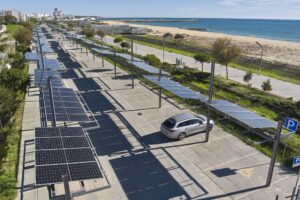By ADRIAN WRIGHT energy@algarveresident.com
Adrian Wright has worked in energy conservation for over 15 years and, in addition to an award winning UK consultancy, is now providing a design and consultancy service in the Algarve through a new company, Ambient Homes. In this series, he will try to help you to save money, protect the environment and have a warmer, healthier home.
WHEN THE Kyoto protocol came into force in February 2005, Portugal had committed to limit the increase of its greenhouse gas emissions, to 27 per cent between 1990 and the first Kyoto commitment period of 2008-2012.
However, within 12 months, José Sócrates’ government admitted that it would be unable to achieve this.
Portugal agreed to limit its emissions to 77.2 Mt CO2e (Mega Tonnes of Carbon Dioxide equivalent) by the end of this decade but predictions estimate that the actual figure will be 84.6 Mt CO2e. In order to plug the 7.4 Mt CO2e gap, the government will be levying additional taxes on Portuguese residents around 354 million euros, over the next five years to buy carbon credits from other countries, under the EU Emissions Trading Scheme.
One of the problems facing the Portuguese government has been the dramatic increase in electricity use and transport, both of which have doubled in the last 10 or so years. The increase in transport emissions has been put down to the improved prosperity of people in Portugal, making cars more affordable, coupled with improved road links making journeys easier. Electricity use has doubled, due to the increased use of air conditioning, the construction of new homes and the increased power used by home appliances.
Under the Portuguese National Climate Programme (PNAC), the government put forward a range of measures to try and meet its Kyoto commitment including:-
Reducing the speed limits on motorways
Reducing the number of days taxis can work
Construction and extension of the metro in Lisbon and Oporto
Increased use of Bio fuels
Improved building standards, better insulation and use of renewable technologies
Increased use of sea transport, rather than road
Increased taxes on incandescent bulbs, heating oil and the cost of new cars
Sócrates announced, in January, that Portugal would aim to generate 45 per cent of its electricity from renewable sources by 2010, an increase of six per cent over their previous commitment.
In addition, he announced a plan to help enable householders to use micro generation to produce their own electricity and have a mechanism in place for them to sell excess power back to the grid. His statement came two days after EDP announced that they would be investing 2.91 billion euros in renewable energy, by 2010.
Signs that Portugal will meet its ambitious target for renewable energy include the recent opening of the world’s largest solar electricity generation plant, with an output of 11Mw, in the Alentejo. This will soon be dwarfed by the 62Mw solar plant being constructed by BP Solar, in Moura, near the Spanish border, which will cover an area the size of 150 football pitches.
Electricity generation from solar energy, although very expensive, generates electricity on a far more reliable basis than other renewable forms, such as hydro or wind. In 2005, power from Portugal’s hydro generation plants were 52 per cent lower than in 2004 due to reduced water flows, caused by drought, which highlights the need for more reliable sources.
In addition to Portugal, six of the original 15 countries that made up the European Union are also unlikely to meet their Kyoto target. These are Austria, Belgium, Denmark, Ireland, Italy and Spain. According to the European Union website, the worst performing of these countries is Spain, which has a commitment under Kyoto to maintain the increase of its emissions to 15 per cent, but predictions for 2010 show the increase will be more than three times higher, at 51.3 per cent.
In contrast to Portugal, whose Kyoto commitment was to limit the increase of emissions to 27 per cent, the UK committed to reduce emissions by 12.5 per cent but voluntarily committed to reduce this even further to 20 per cent, which they are on target to achieve.
Home insulation – a missed opportunity for Portugal
The key mechanisms used in the UK to achieve their emission reductions are large scale home insulation programmes, something the Portuguese government has failed to implement.
In my opinion, this would be a far better option for the Portuguese government to spend their 354 million euros on because in addition to saving energy, a home insulation programme would:-
Support local business and create employment
Save householders money, which would be spent back into the local economy
Reduce fuel poverty and cold related illness
Reduce energy use in Portugal and therefore minimise energy imports
Improving insulation levels on new homes is worthwhile, but new homes make up a fraction of the overall housing stock and it is the existing housing stock that needs to be targeted.
























